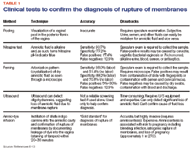Technical innovations in clinical obstetrics
New technology is in the wings to help detect preterm premature rupture of membranes, improve ultrasound imaging, provide noninvasive prenatal genetic screening, and speed up the diagnosis of intra-amniotic infection.
Caring for a pregnant woman is both an enormous privilege and a weighty responsibility. To meet these demands, ob/gyns must constantly keep up with new innovations in their specialty and adapt new recommendations, when they are based on solid clinical research. Unfortunately, given the complexity of human pregnancy and the lack of an adequate animal model, the discipline of clinical obstetrics-unlike specialties like cardiology and neurology-is plagued by a dearth of such studies.
As you know, there are many situations in daily practice where we find ourselves in a "data-free zone," having to make recommendations and management decisions without the benefit of sound evidenced-based data. In those circumstances, clinical experience and the art of medical practice have to take over.
Nowhere is this more apparent than in clinical obstetrics, where many basic questions remain unanswered. While cardiologists measure changes in calcium flux within a single myocardial cell and nephrologists estimate changes in osmotic gradient along a single nephron, ob/gyns continue to debate such questions as: Why is the fetus head down at the end of pregnancy? What causes labor? How do we adequately monitor fetal well-being during labor?
Biochemical tests for pPROM
Preterm premature rupture of membranes (pPROM), the rupture of the fetal membranes prior to 37 weeks' gestation, complicates up to 12% of all pregnancies.1 It also increases the risk of maternal and perinatal complications and death due to placental abruption, cord prolapse, chorioamnionitis, sepsis, and preterm labor and birth. In fact, pPROM is associated with 20% to 40% of all preterm births.2,3 Its early and accurate detection would allow for obstetric interventions that may minimize such complications (such as broad-spectrum antibiotic therapy to prolong latency); a failure to accurately diagnose pPROM may increase the risk of complications.2-5 Similarly, a false-positive diagnosis may result in inappropriate care, including unnecessary hospitalization, administration of antibiotics, tocolytics, corticosteroids, and/or induction of labor.

Clearly then a rapid, accurate, and inexpensive test for pPROM is urgently needed. Several biochemical markers have been measured in vaginal fluid in an attempt to confirm the diagnosis of pPROM-including fetal fibronectin (fFN), alpha-fetoprotein, prolactin, insulin-like growth factor, and human placental lactogen-with variable results.5,15-21 One diagnostic test that is widely used in Europe and has recently been approved by the Food and Drug Administration is AmniSure (N-Dia, Inc., Cambridge, Mass.). An immunoassay that is simple, easy to perform, rapid (5-10 minutes), and noninvasive, AmniSure does not require a speculum examination.
